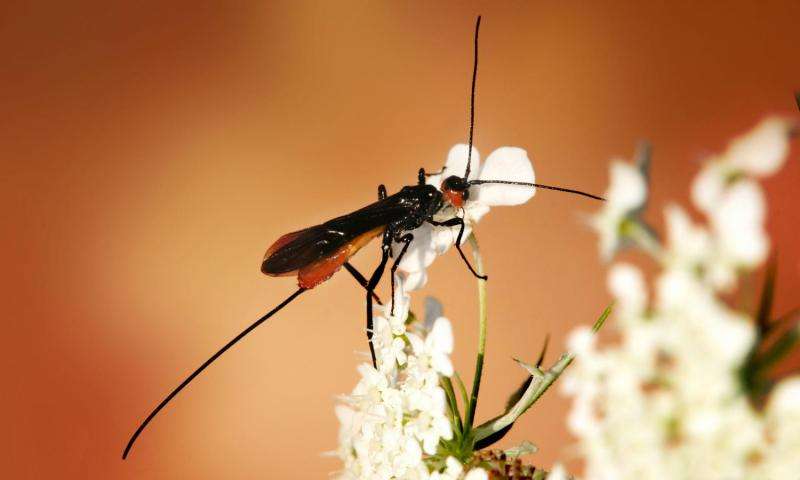Braconidae is a family of parasitoid wasps and one of the richest family of insects. From the approximate 12,000 described species (the braconids), it is extrapolated that between 40,000 and 50,000 species exist worldwide.As shown it is a species of the genus Atanycolus (Braconinae). Credit: Richard Bartz/Wikipedia
Research teams from the University of Valencia and the University of Tours have discovered that genes originating from parasitic wasps are present in the genomes of many butterflies. These genes were acquired through a wasp-associated virus that integrates into DNA. Wasp genes have now been domesticated and likely play a role in in protecting butterflies against other pathogenic viruses.
These results, published in PLOS Genetics on the 17th of September 2015, reveal that butterflies, including the Monarch, an iconic species for naturalists and well-known for its spectacular migrations, constitute naturally produced GMOs (Genetically Modified Organisms) during the course of evolution. This finding relativizes the novelty of producing GM insects, since such insects already exist in nature but also highlights that genes introduced in GM insects can be transferred between distant species.
To reproduce, braconid wasps lay their eggs inside caterpillars and inject a 'giant virus' named bracovirus to circumvent the caterpillars' immune response. Bracoviruses can integrate into the DNA of parasitized caterpillars and control caterpillar development, enabling wasp larvae to colonize their host.
Bracovirus genes can be detected in the genomes of several species of butterfly and moth, including the famous Monarch (Danaus plexippus), the silkworm (Bombyx mori) and insect pests such as the Fall Armyworm (Spodoptera frugiperda) and the Beet Armyworm (Spodoptera exigua). The integrated genes that have been identified are not only remnants: results obtained suggest that they play a protective role against other viruses present in nature, baculoviruses. Strikingly the domestication of genes harboured by bracoviruses is not limited to " viral " genes, some of them originated from the wasp: in armyworm species, a group of genes transferred was shown to be clearly more closely related to genes from hymenoptera, including the honey bee, rather than lepidoptera.
Given that tens of thousands of parasitic wasp species, each associated with a unique bracovirus, parasitize virtually all lepidopteran species, it is likely that the described phenomenon is general and that different gene transfers occur regularly in nature. Beyond the interest these lateral gene transfers evoke in evolutionary biology, these results highlight the risk gene transfers could cause, in case GM-parasitoid wasps are produced, as genes artificially introduced into wasp species used for biological control could be transferred into the genomes of the targeted pests. Production of GM wasps expressing insecticide resistance for biological control of pests, for example, could lead to involuntary transmission of this resistance to the herbivorous insects.
More information: Gasmi L, Boulain H, Gauthier J, Hua-Van A, Musset K, Jakubowska AK, et al. (2015) Recurrent Domestication by Lepidoptera of Genes from Their Parasites Mediated by Bracoviruses. PLoS Genet 11(9): e1005470. DOI: 10.1371/journal.pgen.1005470
Journal information: PLoS Genetics
Provided by Public Library of Science























